Economics Assignment Evaluating Impact of COVID-19 on Businesses in UK
Question
Task:
Economics Assignment Task
The problem-based report is an individual piece of work which enables students to put into practice the principles and data analysis approaches introduced in this module. The report is designed to encourage students to work and learn independently.
You will need to identify a problem and use the data that is freely provided by the office of national statistics (https://www.ons.gov.uk/) to provide a solution to the problem you have identified. When developing your own topics you must consult with the tutor with regards to their appropriateness. Please keep in mind that the focus of this assessment is not on the problem itself but the way you use statistical data to find a solution to the suggested topics.
Answer
1.0Introduction
The UK economy has been facing several economic issues due to the spread of the pandemic. In the current market scenario as portrayed in the economics assignment, the nation is stuck with weak growth along with reduced output due to low productivity and weak demand. It becomes important for researchers and scholars to identify the issues impacting the economy and find a solution through various approaches identified in the theories (Mikolai et al, 2020). Thus, the problem-based approach enables scholars to practice principles and approaches. This report will outline problems faced by the businesses in UK economy and provide a solution with various data analysis approaches.
1.1 Background of Problem
The pandemic spread from China into different regions of the world impacting lives and business cycles in the year 2019. In current scenarios, the pandemic is still not over which has impacted the smooth operations of the business, increased unemployment, high inflation rate, and other factors due to the movement of restrictions for stopping the spread of the virus.
1.2 Research Objective
The objective of this research is to analyse the issues existing in the Businesses of UK economy during the COVID-19 and presenting solutions through data analysis and literature review.
1.3 Research Questions
1. What are the major challenges faced by the UK economy Business during COVID-19?
2. What might be other issues that pre-existing in the UK economy that are impacting business?
2.0Literature Review
The steps undertaken by the UK government have raised awareness about the COVID- 19, symptoms, alertness, and other factors. In this view, the survey conducted in October 2020 revealed that approximately 48% of the individuals in the region were in tier 1 of alert level, with 37% in tier 2 and 10% in tier 3. Thus, every 8 people out of 10 individuals revealed that it was a simple process to find about the alert level while 57% of individuals living in England confirmed that they refer to television news for gaining information on local restrictions. The government reported that the estimated unemployment rate in the UK was recorded at 4.5% that is 0.6 % is higher than in the year 2021. The consumer price index that includes 12 inflation rate was recorded at 0.7% in September 2020 that is higher from August which was 0.5%. In this view, Nicola et al, (2020, p.185) reported that COVID-19, that from December 2019 to April 2020, approximately 4.3 million cases were confirmed, 290,000 deaths occurred globally due to the spread of the virus. To stop the spread of COVID-19, several rules have been formed by international bodies like WHO like social distancing, self-isolation, travel restrictions have resulted in the reduced workforce in many several economic sectors that has also increased unemployment rates in many regions of the world. Colleges and schools remain closed thus,education is being imparted through online mediums while requirements for manufacturing products have also reduced (Altig et al, 2020, p.2). The author also demonstrated that the food sectors have been facing immense pressures as individuals are buying more due to speculation of lockdowns.
Tubadji et al, (2020, p. 52) indicated the uncertainty of economic policy has been greatly influenced. The ARDL model was applied by the author for capturing the short-run and long-run impacts of COVID-19 on the uncertainty of economic policies. The ARDL model in the UK has strong links to the economic policy uncertainty while Brent oil has an inverse relationship in the long- run. In another work by Jeris&Nath (2020, p. 503), showcased that existing cultural and economic divides have been created in several areas in the UK due to life threatening impacts of COVID-19.Mayhew &Anand (2020, p. 2) opined that Job Retention Schemes in the UK have been one of the successful innovations that have helped unemployed workers to keep in contact with their employers. Since the economic recovery of the UK has been slow thus the structure of output and job composition will also vary. The author suggests that active manpower policies are required for matching job seekers with available work in the region. The author also suggests that young job seekers will struggle more so the educational institutions should launch work-based training.
In support of this argument, Baker et al, (2020, p. 2) opined that the UK government should apply forward-looking measures for evaluating the macro-economic impacts of the crisis created by COVID- 19. The author revealed uncertainty shocks in current scenarios are highly volatile as compared to the Great Depression of 1923-1933 and the financial crisis of 2008- 09. Rowthorn&Maciejowski (2020, p. 2)introduced the SIR model of propagating disease. The author suggested that the government should include a capping system for avoiding the overloading of the health systems while also introducing testing and tracing systems. The author contemplated that early intervention would influence the disease in the optimal path. Several cost-effective methods can be adopted by the government for enabling to exit of the lockdown without surging the infections.
Also, a series of lockdowns have been imposed in the country due to which many elderlies are facing mental health issues because being alone for longer times and not able to meet up with new and aged people. In this view, Groarke et al, (2020, p.2) conducted a cross-sectional online survey in which the author found that loneliness prevailed in 27% of individuals residing in the UK. These rates were higher in the initial stages and the younger populations greatly struggled as social contacts were restricted. The ongoing pandemic might increase risk rates on mental health impacts thus, the government and mental health care units should ensure that emotion regulations, sleep qualities and social support should be improved for minimizing the impacts of the COVID-19 on psychological health.
3.0Research Methodology
The research will be conducted by collecting secondary resources and combining qualitative and quantitative methods. The research will be done by analysing all data sources that include Government sources, journals, and newspaper articles that reveal important information on economic impacts of COVID-19 (majorly unemployment and inflation rates as they are co-related) on business units. Since pandemic is new public health issues that `occurred in 2019 and is prevalent till now, hence year range of the data will be from 2014 to 2020. Ethical methods will be adopted that is all sources will be duly referenced in the work. The positivism approach has been followed that is assuming that regularities, causes, and consequences are prevalent in the social world as compared to the natural world.
4.0 Data Analysis and Findings
The employment rate from June to August 2020 was recorded at 75.6% with an unemployment rate of 4.5% that has increased from 0.6 pp from the previous year. The unemployment rate has increased from March 2020 after series of lockdowns were imposed thus employed personnel was reduced by 673,000, a large fall in employment rates was noticed in the initial stages of pandemics (Gov. UK, 2020f). In this view, Figure 1 indicates the impact of COVID-19 on labour markets.
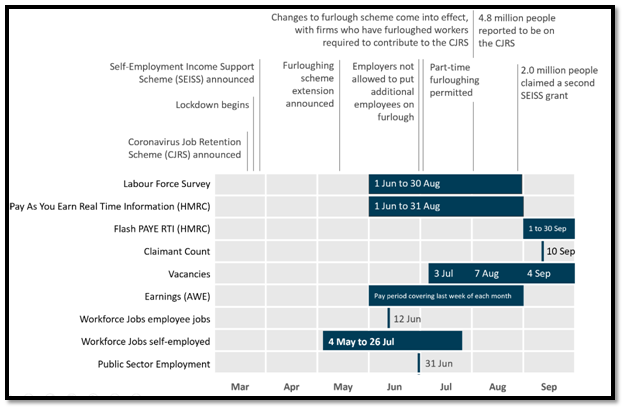
Figure 1:Impact of COVID-19 on Labour Market
(Source: Gov. UK, 2020e)
The government undertook several lockdown measures for protecting businesses and the job market in the region. In the words of ILO, employment is defining any individual working for at least an hour and getting paid for the same (Gov. UK, 2020e). The government launched Job Retention Schemes for workers to return to their jobs after a temporary period of absence. As opined by Mayhew &Anand (2020, p. 2), Job Retention schemes are appropriate innovations for protecting jobs for reducing the economic impacts of COVID-19. Thus, the individuals which can return to their jobs will be classified as employed under ILO. To reduce the levels of unemployment, the government encouraged corporate houses to adopt work from home policies that will protect business as well as a job. As per Figure 2, the value of unemployment rates is revealed, comparing to the previous year, the unemployed individuals were 3.8% from April to December while this has been increased4.1 % in January to April 2020 while this was further increased to 4.5% from July 2020 to Oct 2020.
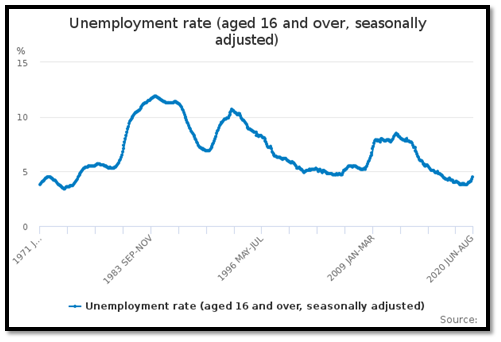
Figure 2:Unemployment Rate in the UK
(Source: Gov. UK, 2020f)
The unemployment rates in the UK also depict the cultural and economic divides that were also revealed by Jeris&Nath (2020, p. 503) in his study. It can be said that COVID-19 has impacted several strata of economic issues like unemployment in society. The unemployed individuals are provided subsidies, but the business is suffering due to reduced demands and labour shortage. The impacts of business can largely be evaluated through consumer price index and inflation rates. Since business is struggling to earn profitable margins, unemployment has increased which has also impacted the inflation rates and consumer index. The Consumer Price Indexes include the owner occupier's housing costs inflation (CPIH) rates for 12 months was recorded at 0.7% in September 2020. Recreation and culture were one of the important points that contributed largely, Eat OUT Help Out schemes was formulated by the government for controlling the transport, restaurant, and café prices and changing the CPIH inflation rates during August and September 2020 (Gov. UK, 2020c). The same has been explained in Figure 3 while figure 4 explains the trading business and weighted rates of employment. Ass opined by Baker et al, (2020, p. 2), the government should use forward-looking measures for tracking the uncertainties in highly volatile economic areas.
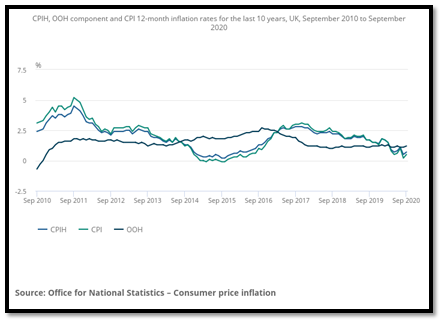
Figure 3:Consumer Price Index and Inflation Rates
(Source: Gov. UK, 2020c)
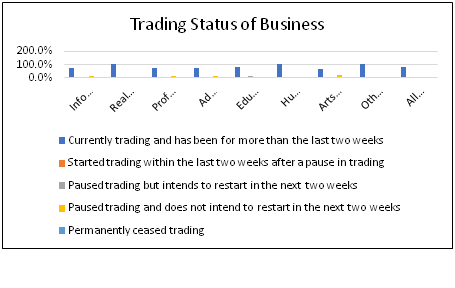
Figure 4: Trading Status of Business
(Source: Gov. UK, 2020c)
The factors like unemployment and inflation have also contributed to the contraction GDP of the nation by 19.8% in the second quarter that is April to June 2020. It was estimated that the GDP of the country would increase in the year 2018 and 2019, However, it fell 0.2% from the estimates (Gov. UK, 2020b). In addition, the companies are unable to export their products and import raw materials from different countries for resuming production and consumption, hence business opportunity is not fully utilized due to COVID-19. The impacts of COVID-19 on economic factors have also influenced the health and societal well being. Since travel restrictions and social distancing is being followed, work from home has increased which has increased mental health issues like loneliness. In this view, Figure 5 explains the working patterns are high for work from home facilities. As depicted by Groarke et al, (2020, p.2), social restrictions have increased the impacts of mental health on the majority of young individuals.
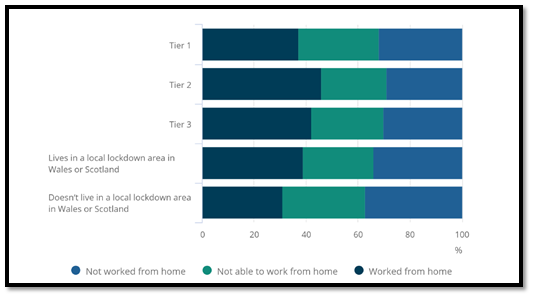
Figure 5:Work Patterns from Oct 21 to 25 (2020)
(Source: Gov. UK, 2020e)
The government has announced an annual pay rise of £930 for workers that are working on a full-time basis while the National Living Wage thus increasing from £8.21 to £8.72, this rate has already started from April 1, 2020, till 25 years. Low-paid workers will be able to receive only a 6.2% pay rise thereby earning £8.72 per hour (Gov. UK, 2020a). The policies should also include freelancers and other self-employed individuals. Also, the high unemployment rate and other economic factors have increased social impacts while also influenced the mental health of individuals. As depicted by Tubadji et al, (2020, p. 52) ARDL model should be applied until the pandemic is over for evaluating the uncertainties in the policies which will also help in reducing the social and economic impacts of COVID-19 on the UK. As proposed by Rowthorn&Maciejowski (2020, p. 2), the government should apply the SIR model developed by the author for capping the systems for avoiding the overloading health systems. This is important as individuals suffering from other diseases are also impacted as all the health care units are catering services to COVID-19 patients. The government should subsidize the health care costs of treatments as the unemployment rate has increased. Until proper medication is developed the government should advise or release propaganda for helping individuals with office supplies and resources for enabling them to work from home. Several policies regarding mental health, subsidies to freelancers should be developed by the government for reducing the impacts of COVID-19 on the UK economy. The government should also provide subsidies to businesses and corporate houses for sustaining the industrial and manufacturing sector.
5.0 Conclusion
The report analysed different social and economic impacts of COVID-19 that negatively influenced the growth of the UK economy. Since travel restrictions, social distancing, and policies are laid by the government, business activities have been severely hampered which has increased the unemployment and inflation rate of the economy. Also, the government needs to adopt several policies to provide subsidies and other facilities for unemployed individuals and business classes. Also, the mental needs of impacted persons should be catered for to cope with the pandemic.
6.0 Reference List
Altig, D., Baker, S., Barrero, J. M., Bloom, N., Bunn, P., Chen, S., ...&Mizen, P., 2020. Economic uncertainty before and during the COVID-19 pandemic. Journal of Public Economics, 191, 104274.
Baker, S. R., Bloom, N., Davis, S. J., & Terry, S. J., 2020. Covid-induced economic uncertainty (No. w26983).National Bureau of Economic Research.
Gov. UK, 2020a.Government announces pay rise for 2.8 million people. [online] Available at:
Gov. UK, 2020c.Consumer price inflation, UK: September 2020. [online] Available at:
Gov. UK, 2020d.Labour market overview, UK: October 2020. [online] Available at:
Gov. UK, 2020e.Coronavirus and the social impacts on Great Britain: 30 October 2020. [online] Available at:
Gov. UK, 2020f.Unemployment rate (aged 16 and over, seasonally adjusted). [online] Available at:
Jeris, S. S., &Nath, R. D., 2020. Covid-19, oil price and UK economic policy uncertainty: evidence from the ARDL approach. Quantitative Finance and Economics, 4(3), 503.
Mayhew, K., &Anand, P., 2020. COVID-19 and the UK Labour Market. Oxford Review of Economic Policy, 36(Supplement_1), S215-S224. Mikolai, J., Keenan, K., and Kulu, H., 2020. Intersecting household-level health and socio-economic vulnerabilities and the COVID-19 crisis: An analysis from the UK.SSM-Population Health, p.100628.
Nicola, M., Alsafi, Z., Sohrabi, C., Kerwan, A., Al-Jabir, A., Iosifidis, C., Agha, M., and Agha, R., 2020. The socio-economic implications of the coronavirus pandemic (COVID-19): A review. International journal of surgery (London, England), 78, p.185.
Rowthorn, R., &Maciejowski, J., 2020. A cost-benefit analysis of the COVID-19 disease.Oxford Review of Economic Policy, 36(Supplement_1), S38-S55.
Tubadji, A., Webber, D. J., & Boy, F. A., 2020. Cultural and economic discrimination by the great leveller: the COVID-19 pandemic in the UK. Covid Economics: Vetted and Real-Time Papers, 13, 51-70.












